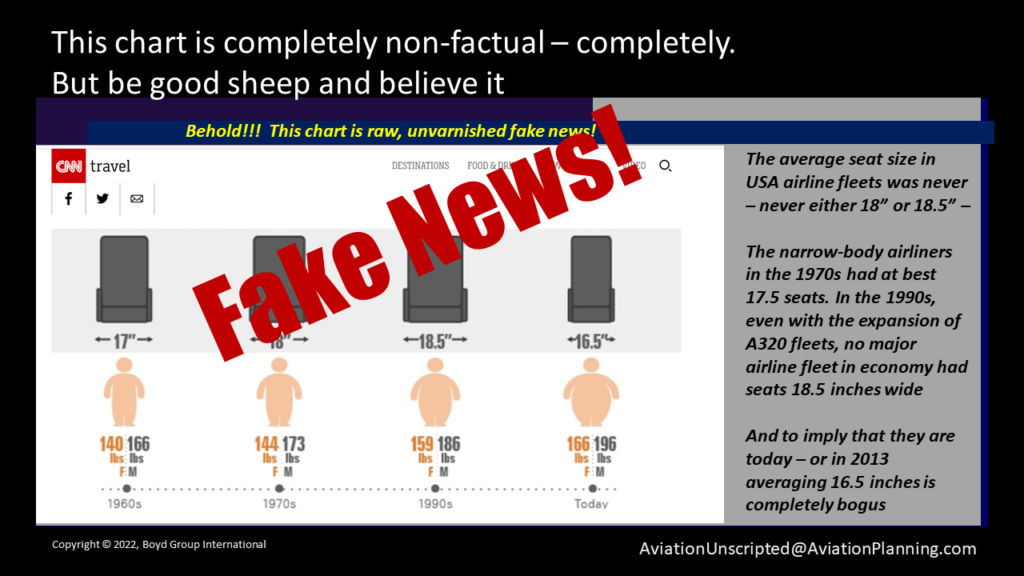We’re Taking On The Media Stampede Regarding Airline Seat Size, and we’ll be reviewing the latest Aviation Unscripted video.
The Fourth Estate: Damn The Facts. Full Speed Ahead! We’d suggest you click here to see the entire 10 minutes of facts and data that illuminate just how far accurate journalism has declined in the USA. The current reporting stampede on airline seat size is an example of me-too nonsense and inaccurate reporting. This post just skims the surface.
Here’s a fact that flies in the face of current trendy media stories about how the “FAA must stop airlines from continuing to shrink the size of airline seats.” The truth is that airlines aren’t doing it.
The truth is that US airlines have not made seats smaller, as most of the fact-less media stories either imply or outright state. Actually the average seat size has increased, putting the lie to repeated media stories that specifically state that seats are being shrunk in size, even quoting bogus inch numbers.
Seat pitch – the distance between rows of seats – has certainly changed from airline to airline. Yikes! In some cases down to 28 inches, which is really tight for the knees. But the media stories almost always include the dishonest drivel that the actual seat itself is smaller airlines and that airlines re continuing to shrink them. Those contentions are pure fake news. in light of the supposed high level of a lot of these sources, the term “lie” comes into play.
The actual width of the chair the passenger sits on has not shrunk. In fact, on average, it is actually grown in the past 20 years.
Fact: the seat width on Boeing single aisle airliners in 6-across economy cabins has not declined. In clear truth, the cabin dimensions of a new 737MAX are essentially identical to the first 707s that entered service in 1958. In that, the economy cabin seats have always been @17.5 inches. The construction of the seats has improved over the years, with new engineering and design. But they are not – repeat, not – shrunken and smaller, as the new media mantra implies.
Fact: As the Airbus A320 platform came into fleets over the past 30 years, this injected thousands of economy seats that were wider than those on Boeing’s models – at 18+ inches. Then came the entry of the Embraer E175s and E190s, also with seats wider than the Boeing narrowbody 737s and 727s. Now, we have the entry of the game-changing A220, with seats nearing 19 inches wide.
It doesn’t take a degree from Wharton to see the reality. The media stories about shrinking airline seats are completely bogus.On average, it’s going up, since airliners with wider seats are entering service and earlier models are not – not – seeing seat size reduced. Tighter density is not the same as airline seat size, and most of the condescending drivel stories are stating.
It gets worse. Take a look at this dishonest and misleading chart put out by CNN. It was originally from a story in 2013, but they have linked it to current articles, implying it is accurate today. It was journalistic sewage in 2013 and remains so today.
 Regardless of the size of humans, the data on the average airline seat width is completely and possibly intentionally inaccurate.
Regardless of the size of humans, the data on the average airline seat width is completely and possibly intentionally inaccurate.
To start, at no time in the 1970s did the average economy seat average of 18.5 inches. In fact, with the rare exception of one airline occasionally trying 5-across seating on DC-8s, there were essentially no such seats in the economy cabin skies.
Nor are average seat widths today 16.5 inches. On some of the retiring CRJ and ERJ “regional jets” yes. But that is not the average for the industry. It’s possible some ethically-defective reporter was including first class seats in the mix in the numbers, but that would not account for the completely dishonest claim that airlines have now shrunk seats down to 16.5-inch width on average.
Makes a great 5-minute piece on the evening news or maybe a wallow piece on 60 Minutes, but that data is false.
Making Seats Narrower Won’t Deliver More Capacity. Six Across Is It. Then there is the claim that by making the seat less wide, they can squeeze more into the airplane. To be clear, new advances in materials and engineering, not to mention changes in FAA seat attachment requirements have made seats lighter – but not narrower and not necessarily less comfortable. Somehow, many of these media pieces imply that with shrunken seat width, greedy airlines can get more capacity. The fact is that 6-across is the maximum and cutting 2-3 inches off the width of the seat won’t do bupkus to allow for more than 6.
Okay, there is an issue with legroom. The argument can be made that at under 30-inch pitch, the economy cabin is the equivalent of a Roman slave galley with beverage service. But not with narrower seats. Just more rows.
The issue here is that these current configurations meet FAA emergency exit requirements. That raises the question of whether these standards need to be revised, based on factual data, not the opinions of some semi-comatose consumer gadflies.
The bottom line of this is that the media in general is passing on misinformation, innuendo and in some cases completely and intentionally inaccurate data.
This Can Affect Air Service Access. Aviation leaders need to be informed. Keep in mind, this type of bogus data could lead to the politically-driven inhabitants at the top of the FAA dictating new regulations that restrict capacity, which will in turn change operational economic for mid-size and small airports.
The only question is whether these cabins are safe.
Get the facts. Click here for the latest Aviation Unscripted video.
Ten minutes that can clear the air.
